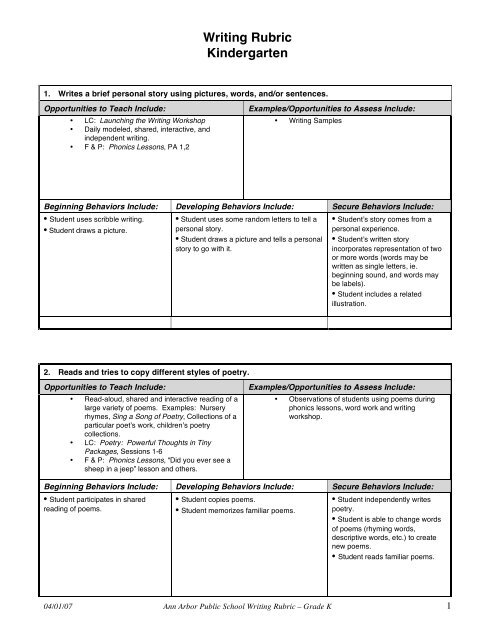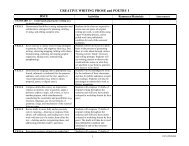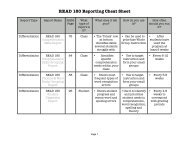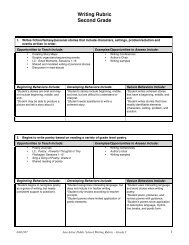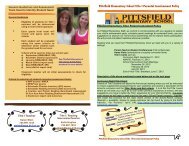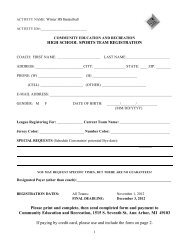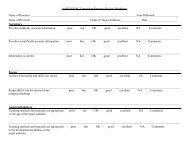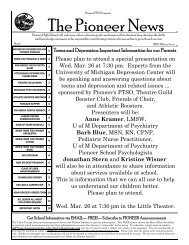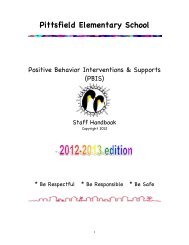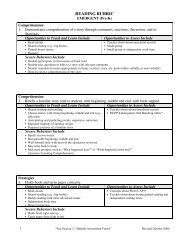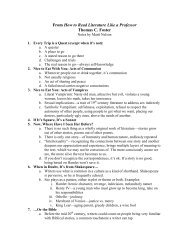Writing Rubric Kindergarten - Ann Arbor Public Schools
Writing Rubric Kindergarten - Ann Arbor Public Schools
Writing Rubric Kindergarten - Ann Arbor Public Schools
Create successful ePaper yourself
Turn your PDF publications into a flip-book with our unique Google optimized e-Paper software.
<strong>Writing</strong> <strong>Rubric</strong><br />
<strong>Kindergarten</strong><br />
1. Writes a brief personal story using pictures, words, and/or sentences.<br />
Opportunities to Teach Include:<br />
• LC: Launching the <strong>Writing</strong> Workshop<br />
• Daily modeled, shared, interactive, and<br />
independent writing.<br />
• F & P: Phonics Lessons, PA 1,2<br />
Examples/Opportunities to Assess Include:<br />
• <strong>Writing</strong> Samples<br />
Beginning Behaviors Include: Developing Behaviors Include: Secure Behaviors Include:<br />
• Student uses scribble writing.<br />
• Student draws a picture.<br />
• Student uses some random letters to tell a<br />
personal story.<br />
• Student draws a picture and tells a personal<br />
story to go with it.<br />
• Student’s story comes from a<br />
personal experience.<br />
• Student’s written story<br />
incorporates representation of two<br />
or more words (words may be<br />
written as single letters, ie.<br />
beginning sound, and words may<br />
be labels).<br />
• Student includes a related<br />
illustration.<br />
2. Reads and tries to copy different styles of poetry.<br />
Opportunities to Teach Include:<br />
• Read-aloud, shared and interactive reading of a<br />
large variety of poems. Examples: Nursery<br />
rhymes, Sing a Song of Poetry, Collections of a<br />
particular poet’s work, children’s poetry<br />
collections.<br />
• LC: Poetry: Powerful Thoughts in Tiny<br />
Packages, Sessions 1-6<br />
• F & P: Phonics Lessons, “Did you ever see a<br />
sheep in a jeep” lesson and others.<br />
Examples/Opportunities to Assess Include:<br />
• Observations of students using poems during<br />
phonics lessons, word work and writing<br />
workshop.<br />
Beginning Behaviors Include: Developing Behaviors Include: Secure Behaviors Include:<br />
• Student participates in shared<br />
reading of poems.<br />
• Student copies poems.<br />
• Student memorizes familiar poems.<br />
• Student independently writes<br />
poetry.<br />
• Student is able to change words<br />
of poems (rhyming words,<br />
descriptive words, etc.) to create<br />
new poems.<br />
• Student reads familiar poems.<br />
04/01/07 <strong>Ann</strong> <strong>Arbor</strong> <strong>Public</strong> School <strong>Writing</strong> <strong>Rubric</strong> – Grade K 1
<strong>Writing</strong> <strong>Rubric</strong><br />
<strong>Kindergarten</strong><br />
3. Writes a brief informational piece using drawings, words and/or sentences as a page for a class<br />
book.<br />
Opportunities to Teach Include:<br />
• Read-alouds and shared reading of<br />
informational texts.<br />
• <strong>Writing</strong> predictable charts and class books on<br />
topics such as favorite foods, colors, activities<br />
and so on, or field trip reflections.<br />
• F & P: Phonics Lessons, ELC 3<br />
• LC: Nonfiction <strong>Writing</strong>: Procedures and<br />
Reports, Session 11<br />
Examples/Opportunities to Assess Include:<br />
• <strong>Writing</strong> samples of class books.<br />
Beginning Behaviors Include: Developing Behaviors Include: Secure Behaviors Include:<br />
• Student creates page using<br />
drawings, labels, words and/or<br />
sentences that are not related to<br />
topic.<br />
• Student contributes page related to<br />
informational topic with teacher assistance.<br />
• Student independently<br />
contributes one page for a class<br />
book using drawings, labels or<br />
words, and/or sentences (words<br />
can be beginning, middle, or<br />
ending letter sounds).<br />
• Information on student’s page is<br />
related to the main idea of the class<br />
book.<br />
4. Helps with a class research project by adding key information gathered from materials supplied by<br />
the teacher.<br />
Opportunities to Teach Include:<br />
• Read-alouds and shared reading of science and<br />
social studies unit topics.<br />
• Direct teaching of structure of informational<br />
texts.<br />
• LC: Nonfiction <strong>Writing</strong>: Procedures and<br />
Reports, Sessions 7-11<br />
Examples/Opportunities to Assess Include:<br />
• Participation in gathering information.<br />
• Participation in shared, interactive and<br />
independent writing of class books.<br />
Beginning Behaviors Include: Developing Behaviors Include: Secure Behaviors Include:<br />
• Student does not use materials to<br />
gather information.<br />
• Student writes or draws on random<br />
topic.<br />
• Student gathers factual information with<br />
teacher assistance.<br />
• Student writes key information in words<br />
and/or sentences for class book with teacher<br />
assistance.<br />
• Student demonstrates ability to<br />
gather factual information from<br />
materials.<br />
• Student writes key information in<br />
words and/or sentences for class<br />
book. (Example: writes b fr (brown<br />
fur) in guinea pig book.<br />
04/01/07 <strong>Ann</strong> <strong>Arbor</strong> <strong>Public</strong> School <strong>Writing</strong> <strong>Rubric</strong> – Grade K 2
<strong>Writing</strong> <strong>Rubric</strong><br />
<strong>Kindergarten</strong><br />
5. Brainstorms ideas for narrative stories.<br />
Opportunities to Teach Include:<br />
• Teacher models how she comes up with ideas<br />
out of her own experience.<br />
• LC: Launching the <strong>Writing</strong> Workshop,<br />
Session 1<br />
Examples/Opportunities to Assess Include:<br />
• Observation and anecdotal notes: Children’s<br />
writing reflects their life stories.<br />
• <strong>Writing</strong> conferences<br />
Beginning Behaviors Include: Developing Behaviors Include: Secure Behaviors Include:<br />
• Student is not able to choose topics • Student able to choose multiple writing • Student independently chooses<br />
for own writing.<br />
topics with teacher assistance.<br />
writing topics from own experience.<br />
6. Produces pictures and drawings that fit the story.<br />
Opportunities to Teach Include:<br />
• Read-alouds, shared reading<br />
• Encourage students to elaborate on the<br />
meaning contained in the pictures they draw.<br />
• Daily interactive writing to draw attention to<br />
print.<br />
• LC: Launching the <strong>Writing</strong> Workshop:<br />
Sessions 2, 4, 5<br />
Examples/Opportunities to Assess Include:<br />
• Work Samples<br />
• <strong>Writing</strong> Conferences<br />
Beginning Behaviors Include: Developing Behaviors Include: Secure Behaviors Include:<br />
• Student makes random marks and • Student writing and picture are not related. • Student draws pictures relevant<br />
scribbles.<br />
to the topic they tell or write about.<br />
04/01/07 <strong>Ann</strong> <strong>Arbor</strong> <strong>Public</strong> School <strong>Writing</strong> <strong>Rubric</strong> – Grade K 3
<strong>Writing</strong> <strong>Rubric</strong><br />
<strong>Kindergarten</strong><br />
7. As s/he plans to write, with help from the teacher, thinks about how the readers will react.<br />
Opportunities to Teach Include:<br />
• LC: Small Moments: Session 7<br />
• LC: <strong>Writing</strong> for Readers: Sessions 1, 2, 10<br />
• LC: Conferring Handbook: “Touching the<br />
Page”, p. 16<br />
• LC: Nonfiction <strong>Writing</strong>, Session 2, 3, 9<br />
• Individual <strong>Writing</strong> Conferences<br />
Examples/Opportunities to Assess Include:<br />
• Individual and group conferences.<br />
Beginning Behaviors Include: Developing Behaviors Include: Secure Behaviors Include:<br />
Before writing, when teacher asks, • Before writing, when teacher asks, student • Before writing, when teacher<br />
student cannot suggest topic.<br />
gives broad topic without details of story. asks, student is able to share plan<br />
for writing and details of story<br />
which s/he thinks the reader will<br />
find interesting or informative.<br />
8. Spells words based on how they sound.<br />
Opportunities to Teach Include:<br />
• LC: Launching the <strong>Writing</strong> Workshop:<br />
Sessions 7, 8<br />
• LC: Small Moments: Session 5<br />
• LC: <strong>Writing</strong> for Readers: Session 3<br />
• F & P: Phonics Lessons: PA 7, 17, 18, 23,<br />
WSA 2, 3<br />
Examples/Opportunities to Assess Include:<br />
• <strong>Writing</strong> Samples<br />
• Written word work<br />
Beginning Behaviors Include: Developing Behaviors Include: Secure Behaviors Include:<br />
• Student cannot represent words<br />
with appropriate letter sounds.<br />
• Student can say words slowly, hear and<br />
write one sound from beginning, middle, or<br />
end or words.<br />
• Student can say words slowly,<br />
hear and write at least two letter<br />
sounds from the beginning, middle,<br />
or end of words.<br />
04/01/07 <strong>Ann</strong> <strong>Arbor</strong> <strong>Public</strong> School <strong>Writing</strong> <strong>Rubric</strong> – Grade K 4
<strong>Writing</strong> <strong>Rubric</strong><br />
<strong>Kindergarten</strong><br />
9. Brainstorms ideas for informational text.<br />
Opportunities to Teach Include:<br />
• Read-alouds and shared reading of<br />
informational text.<br />
• Teacher models how s/he comes up with ideas<br />
to choose informational topic to write about.<br />
• LC: Nonfiction <strong>Writing</strong>: Session 1<br />
Examples/Opportunities to Assess Include:<br />
• Participation in group discussion.<br />
• Anecdotal notes from conferences<br />
Beginning Behaviors Include: Developing Behaviors Include: Secure Behaviors Include:<br />
• Student cannot self-generate<br />
informational topic.<br />
• Student can choose informational topic with<br />
teacher assistance.<br />
• Student independently chooses<br />
an informational topic to write<br />
about.<br />
10. Makes changes to his/her writing by reading it to a friend, and asks for ideas to improve it to make<br />
the meaning more clear.<br />
Opportunities to Teach Include:<br />
• LC: Small Moments: Session 3–<br />
• Student responds to:<br />
• What did you write yesterday?<br />
• Are you done or will you add on?<br />
• How will your story go?<br />
• LC: Small Moments, Session 14<br />
• LC: The Craft of Revision, Session 12<br />
• Teacher modeling and charts available for<br />
reference<br />
Examples/Opportunities to Assess Include:<br />
• Observation of writing partnerships<br />
Beginning Behaviors Include: Developing Behaviors Include: Secure Behaviors Include:<br />
• Student does not participate in peer<br />
conferring.<br />
• With teacher assistance, student adds or<br />
changes words or conventions of print in<br />
his/her text based on peer conferring.<br />
• With teacher assistance, student asks<br />
peers for ideas about writing.<br />
• Student adds or changes words<br />
or conventions of print in his/her<br />
text based on peer conferring.<br />
• Student asks peers for ideas<br />
about writing.<br />
04/01/07 <strong>Ann</strong> <strong>Arbor</strong> <strong>Public</strong> School <strong>Writing</strong> <strong>Rubric</strong> – Grade K 5
<strong>Writing</strong> <strong>Rubric</strong><br />
<strong>Kindergarten</strong><br />
11. Expresses feelings, uses his/her natural language and creates new ideas to show originality in<br />
his/her speech and writing.<br />
Opportunities to Teach Include:<br />
• LC: Small Moments: Session 9<br />
• Teacher modeling during writing<br />
Examples/Opportunities to Assess Include:<br />
• Teacher looks for student writing that conveys<br />
feeling without necessarily using feeling words:<br />
Example: My dad bought me a hot dog which I<br />
ate slowly bite by bite by bite. Or: When my dog<br />
died I cried and cried.<br />
Beginning Behaviors Include: Developing Behaviors Include: Secure Behaviors Include:<br />
• Student does not incorporate<br />
descriptive language in writing.<br />
• With teacher assistance, student writes<br />
sentences which convey what s/he feels<br />
using descriptive language.<br />
• With teacher assistance, student conveys<br />
feelings in his/her writing about a variety of<br />
topics over time.<br />
• Student writes sentences that<br />
convey what s/he feels using<br />
descriptive language.<br />
• Student conveys feelings in<br />
his/her writing about a variety of<br />
topics over time.<br />
12. Uses beginning and simple ending sounds, or word lists provided by the teacher to figure out how<br />
to spell more words.<br />
Opportunities to Teach Include:<br />
• F & P: Phonics Lessons LS 1, 2, 4, PA 12, 13<br />
• LC: Small Moments: Session 5<br />
• LC: <strong>Writing</strong> for Readers: Session 7<br />
• Create and use word wall, word lists, and<br />
personal word bank.<br />
Examples/Opportunities to Assess Include:<br />
• Observations and anecdotal notes<br />
• <strong>Writing</strong> samples<br />
• Student can share how s/he figured out how to<br />
spell a word.<br />
Beginning Behaviors Include: Developing Behaviors Include: Secure Behaviors Include:<br />
• Student writes with no letter-sound • Student writes with a single sound only for<br />
correlation.<br />
each word in their sentence.<br />
• Student can spell unknown words<br />
by using knowledge of soundsymbol<br />
relationships.<br />
• Student can say words slowly,<br />
hear sounds at the beginning and<br />
end of words and connect with<br />
some letters.<br />
• Student represents whole words<br />
with two or more letters.<br />
• Student copies words from<br />
environmental resources.<br />
04/01/07 <strong>Ann</strong> <strong>Arbor</strong> <strong>Public</strong> School <strong>Writing</strong> <strong>Rubric</strong> – Grade K 6
<strong>Writing</strong> <strong>Rubric</strong><br />
<strong>Kindergarten</strong><br />
13. Correctly spells about 18 words s/he sees often and finds meaningful.<br />
Opportunities to Teach Include:<br />
• Creating and using word wall, word lists,<br />
personal word banks<br />
• LC: <strong>Writing</strong> for Readers, Sessions 4, 7, 8<br />
• F & P: Phonics Lessons, HF 1 -4, LK 4<br />
Examples/Opportunities to Assess Include:<br />
• <strong>Writing</strong> samples<br />
• Observations/anecdotal notes from interactive<br />
and independent writing.<br />
Beginning Behaviors Include: Developing Behaviors Include: Secure Behaviors Include:<br />
• Student writes 0-9 words correctly • Student writes 10-17 words correctly on • Student writes 18+ words<br />
on Ten Minutes Word Write<br />
Ten Minute Word Write assessment.<br />
correctly on Ten Minute Word Write<br />
assessment.<br />
assessment.<br />
14. Writes from left to right and top to bottom.<br />
Opportunities to Teach Include:<br />
• Daily interactive writing<br />
• Direct and intentional instruction during<br />
modeled writing.<br />
• Daily opportunities for independent writing.<br />
• LC: Nuts and Bolts of Teaching <strong>Writing</strong>:<br />
Chapter 8<br />
Examples/Opportunities to Assess Include:<br />
• Observation during independent writing periods.<br />
• Anecdotal notes.<br />
Beginning Behaviors Include: Developing Behaviors Include: Secure Behaviors Include:<br />
• Student labels pictures.<br />
• Students may not consistently demonstrate • Student demonstrates return<br />
return sweep.<br />
sweep when writing.<br />
04/01/07 <strong>Ann</strong> <strong>Arbor</strong> <strong>Public</strong> School <strong>Writing</strong> <strong>Rubric</strong> – Grade K 7
<strong>Writing</strong> <strong>Rubric</strong><br />
<strong>Kindergarten</strong><br />
15. Forms upper and lower case letters.<br />
Opportunities to Teach Include:<br />
• Explicit instruction in handwriting: F & P:<br />
Verbal Path, Handwriting Without Tears<br />
• F & P: Phonics Lessons: ELC 1, LK 3, 9, 12,<br />
16<br />
• Daily opportunities to write<br />
• Provision of models that are easily accessible<br />
(alphabet strips and linking charts, word walls)<br />
Examples/Opportunities to Assess Include:<br />
• <strong>Writing</strong> Samples<br />
Beginning Behaviors Include: Developing Behaviors Include: Secure Behaviors Include:<br />
• Student forms letter-like scribbles. • Student is beginning to form letters in a<br />
recognizable way.<br />
• Student can correctly form most<br />
letters, though may still mix upper<br />
and lowercase and may still<br />
reverse some letters.<br />
16. Leaves spaces between words when writing.<br />
Opportunities to Teach Include:<br />
• Daily interactive writing.<br />
• Direct and intentional instruction during<br />
modeled writing, shared writing, and interactive<br />
writing.<br />
• Make it/break it sentence building activities<br />
• LC: <strong>Writing</strong> for Readers: Session 5<br />
• F & P: Phonics Lessons, ELC 3, 8<br />
Examples/Opportunities to Assess Include:<br />
• <strong>Writing</strong> Samples<br />
Beginning Behaviors Include: Developing Behaviors Include: Secure Behaviors Include:<br />
• Student does not leave spaces<br />
between words.<br />
• Student inconsistently leaves spaces<br />
between words.<br />
• Student uses marks (ex: dash, slash, dot,<br />
etc.) to distinguish spaces between words.<br />
• Student consistently leaves<br />
spaces between words when<br />
writing.<br />
04/01/07 <strong>Ann</strong> <strong>Arbor</strong> <strong>Public</strong> School <strong>Writing</strong> <strong>Rubric</strong> – Grade K 8
<strong>Writing</strong> <strong>Rubric</strong><br />
<strong>Kindergarten</strong><br />
17. Is eager to write and learn to write.<br />
Opportunities to Teach Include:<br />
• Teacher models joy of writing in a variety of<br />
classroom activities such as modeled writing,<br />
shared writing, interactive writing and<br />
independent writing.<br />
• Teacher shows interest and excitement about<br />
writing that student produces.<br />
Examples/Opportunities to Assess Include:<br />
• Observation as students write, ie. Student<br />
willingly participates in opportunities to write<br />
during the school day: writing workshop,<br />
phonics and word work, writing center.<br />
• Writes for own purposes such as labeling a block<br />
tower, writing in the playhouse, and writing notes<br />
to friends and family.<br />
Beginning Behaviors Include: Developing Behaviors Include: Secure Behaviors Include:<br />
• Student does not engage in writing • Student needs teacher assistance to<br />
tasks.<br />
maintain engagement in writing tasks.<br />
• Student writes without adult<br />
coaxing.<br />
• Student attempts and/or<br />
incorporates new skills taught in<br />
mini-lessons.<br />
• Student perseveres when writing.<br />
• Student writes for a variety of<br />
purposes.<br />
04/01/07 <strong>Ann</strong> <strong>Arbor</strong> <strong>Public</strong> School <strong>Writing</strong> <strong>Rubric</strong> – Grade K 9


